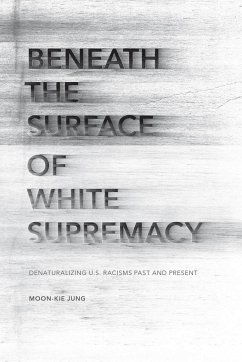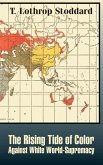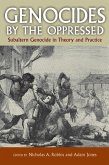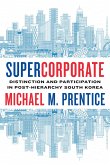- Broschiertes Buch
- Merkliste
- Auf die Merkliste
- Bewerten Bewerten
- Teilen
- Produkt teilen
- Produkterinnerung
- Produkterinnerung
Beneath the Surface of White Supremacy upends and deepens our understanding of racism, providing a radical alternative to conservatives' and liberals' contorted renderings of the past and false promises for the future.
Andere Kunden interessierten sich auch für
![Rising Tide of Color Against White World-Supremacy, The Rising Tide of Color Against White World-Supremacy, The]() T. Lothrop StoddardRising Tide of Color Against White World-Supremacy, The23,99 €
T. Lothrop StoddardRising Tide of Color Against White World-Supremacy, The23,99 €![What Lies Beneath What Lies Beneath]() Steven CohenWhat Lies Beneath20,99 €
Steven CohenWhat Lies Beneath20,99 €![The Antiracist The Antiracist]() Kondwani FidelThe Antiracist16,99 €
Kondwani FidelThe Antiracist16,99 €![Genocides by the Oppressed Genocides by the Oppressed]() Genocides by the Oppressed29,99 €
Genocides by the Oppressed29,99 €![End of Anger, The End of Anger, The]() Ellis CoseEnd of Anger, The19,99 €
Ellis CoseEnd of Anger, The19,99 €![Supercorporate Supercorporate]() Michael PrenticeSupercorporate37,99 €
Michael PrenticeSupercorporate37,99 €![The Iceman Inheritance The Iceman Inheritance]() Michael BradleyThe Iceman Inheritance15,99 €
Michael BradleyThe Iceman Inheritance15,99 €-
-
-
Beneath the Surface of White Supremacy upends and deepens our understanding of racism, providing a radical alternative to conservatives' and liberals' contorted renderings of the past and false promises for the future.
Hinweis: Dieser Artikel kann nur an eine deutsche Lieferadresse ausgeliefert werden.
Hinweis: Dieser Artikel kann nur an eine deutsche Lieferadresse ausgeliefert werden.
Produktdetails
- Produktdetails
- Verlag: Stanford University Press
- Seitenzahl: 264
- Erscheinungstermin: 6. Mai 2015
- Englisch
- Abmessung: 226mm x 150mm x 13mm
- Gewicht: 318g
- ISBN-13: 9780804795197
- ISBN-10: 0804795193
- Artikelnr.: 41749739
- Herstellerkennzeichnung
- Produktsicherheitsverantwortliche/r
- Europaallee 1
- 36244 Bad Hersfeld
- gpsr@libri.de
- Verlag: Stanford University Press
- Seitenzahl: 264
- Erscheinungstermin: 6. Mai 2015
- Englisch
- Abmessung: 226mm x 150mm x 13mm
- Gewicht: 318g
- ISBN-13: 9780804795197
- ISBN-10: 0804795193
- Artikelnr.: 41749739
- Herstellerkennzeichnung
- Produktsicherheitsverantwortliche/r
- Europaallee 1
- 36244 Bad Hersfeld
- gpsr@libri.de
Moon-Kie Jung teaches sociology at the University of Massachusetts. He is the author of Reworking Race: The Making of Hawaii's Interracial Labor Movement (2006) and co-editor of State of White Supremacy: Racism, Governance, and the United States (Stanford, 2011).
Contents and Abstracts
1Introduction: Reconsidering Racism and Theory
chapter abstract
This introductory chapter begins with a close description and analysis of
the homicide of an unarmed Black teen in Champaign, Illinois. On October 9,
2009, the police shot and killed Kiwane Carrington outside a friend's home
where he was staying. The officers involved were never charged, much less
convicted. The chapter attempts to defamiliarize what has become all too
familiar and discern the racial common sense that prevailed in the case.
Through this particular example, it raises a multitude of general questions
about the workings of racism that the rest of the book takes up.
2Restructuring a Theory of Racism
chapter abstract
Chapter two outlines a new theory of racism, an indispensable, if deeply
fraught, concept in the social sciences. It builds on Eduardo
Bonilla-Silva's structural theory of racism and William Sewell Jr.'s theory
of structure. The former goes a long way toward denaturalizing
commonsensical views on racism by stressing its structural character.
Insightful in myriad ways, it is hindered by an unsatisfactory concept of
structure. Integrating, critiquing, and extending Sewell's more cultural
and historical understanding of structure, the new theory addresses a
number of thorny issues, including scale, meaning, consciousness, and
change. To do so, it distinguishes between dominant and subaltern
positions, discursive and nondiscursive practices, and performative and
reflective discourses. Foregrounding the practical over the
representational, the restructured theory squares a host of seemingly
contradictory theories and findings in the social-scientific study of
racism.
3The Racial Constitution of the U.S. Empire-State
chapter abstract
Against the universal assumption that the United States is and has been a
nation-state, chapter three contends that the United States has always been
an empire-state, a conceptual shift with potentially sweeping implications.
Notably, the reconceptualization provides a firmer basis for understanding
the United States as a racial state, requiring none of liberalism's
contortions of the past and false promises for the future. For its
empirical analysis, the chapter turns to constitutional law of the long
nineteenth century. It demonstrates how U.S. state formation has always
entailed the racial construction of colonial spaces. Tracing the strange
career of Dred Scott v. Sandford, the notorious Supreme Court case
associated almost always with slavery and almost never with empire, it
argues for a unified framework to analyze the different but linked
histories of racial subjection, including those of Asians/Asian Americans,
Blacks, Latinas/os, Native Americans, and Pacific Islanders.
4The Racial Unconscious of Assimilation Theories
chapter abstract
Chapter four scrutinizes the current social-scientific literature on
immigration and immigrants. Over the past two decades, immigration scholars
have revitalized assimilation theory to study the large and growing numbers
of migrants from Latin America, Asia, and the Caribbean in the United
States. Neoclassical and segmented assimilation theories seek to make sense
of this current wave of migrants and their offspring that differs in
important ways from the last great wave at the turn of the twentieth
century. They also recognize and try to overcome the conceptual
shortcomings of earlier generations of assimilation theory. Yet the new
theories continue to misconstrue race by assuming precisely what should be
dissected: the "nation-state" and structures of inequality and domination.
Shifting the focus from difference to inequality and domination, the
chapter proposes a fundamental reorientation in our theoretical approach,
from assimilation to the politics of national belonging.
5Symbolic Coercion and a Massacre of Filipinos
chapter abstract
Chapter five investigates a mostly forgotten massacre that took place in
Hawai'i on September 9, 1924. During a protracted strike of Filipino sugar
workers, the police shot and killed sixteen strikers on the island of
Kaua'i. The incident hardly registered, failing to arouse among
non-Filipinos sympathy or questions of legitimacy. How is such immediate
consensus in defense of state violence formed? Incorporating W. E. B. Du
Bois's concept of double consciousness, the chapter puts forward a critique
of Pierre Bourdieu's social theory that challenges his overreliance on the
tacit consent of the oppressed as the source of legitimacy. Exposing clear
evidence of Filipino strikers' oppositional discourse and practice that
went ignored, it proposes the concept of symbolic coercion that refers to
the tacit nonrecognition by the dominant.
6Symbolic Perversity and the Mass Suffering of Blacks
chapter abstract
Chapter six proffers the concept of symbolic perversity, the paradoxical
but pervasive phenomenon of the relatively powerful's ignorance of their
own knowledge. Despite the prevailing liberal notion that the dominant,
like all people, would act justly if they knew about this or that
injustice, the chapter underscores the idea that they know plenty but
tacitly ignore this knowledge that they themselves produce and consume.
This deeply patterned ignorance follows a racial logic that devalues the
suffering of certain categories of people. To illustrate, statistical and
textual analyses of the New York Times, a dominant institution, and its
handling of unemployment data produced by the federal government, another
dominant institution, are undertaken. The findings on Black unemployment
and its news coverage fly in the face of conventional wisdoms that racism
in contemporary United States is hard to detect and that nearly everybody
believes in racial equality in principle.
Conclusion: Denaturalizing Racisms Present and Future
chapter abstract
This concluding chapter draws out some of the book's main implications for
theory and politics of race through a reflection on the social thought of
James Baldwin. It highlights the many points of convergence between the
book and Baldwin's ideas, including emphases on history, relations of
power, social unconscious, ignorance, immanent critique, violence, chimera
of assimilation, and radical change. It also discusses two points of
divergence: the need to recognize qualitatively different racisms and the
incompatibility of radical antiracism and "America."
1Introduction: Reconsidering Racism and Theory
chapter abstract
This introductory chapter begins with a close description and analysis of
the homicide of an unarmed Black teen in Champaign, Illinois. On October 9,
2009, the police shot and killed Kiwane Carrington outside a friend's home
where he was staying. The officers involved were never charged, much less
convicted. The chapter attempts to defamiliarize what has become all too
familiar and discern the racial common sense that prevailed in the case.
Through this particular example, it raises a multitude of general questions
about the workings of racism that the rest of the book takes up.
2Restructuring a Theory of Racism
chapter abstract
Chapter two outlines a new theory of racism, an indispensable, if deeply
fraught, concept in the social sciences. It builds on Eduardo
Bonilla-Silva's structural theory of racism and William Sewell Jr.'s theory
of structure. The former goes a long way toward denaturalizing
commonsensical views on racism by stressing its structural character.
Insightful in myriad ways, it is hindered by an unsatisfactory concept of
structure. Integrating, critiquing, and extending Sewell's more cultural
and historical understanding of structure, the new theory addresses a
number of thorny issues, including scale, meaning, consciousness, and
change. To do so, it distinguishes between dominant and subaltern
positions, discursive and nondiscursive practices, and performative and
reflective discourses. Foregrounding the practical over the
representational, the restructured theory squares a host of seemingly
contradictory theories and findings in the social-scientific study of
racism.
3The Racial Constitution of the U.S. Empire-State
chapter abstract
Against the universal assumption that the United States is and has been a
nation-state, chapter three contends that the United States has always been
an empire-state, a conceptual shift with potentially sweeping implications.
Notably, the reconceptualization provides a firmer basis for understanding
the United States as a racial state, requiring none of liberalism's
contortions of the past and false promises for the future. For its
empirical analysis, the chapter turns to constitutional law of the long
nineteenth century. It demonstrates how U.S. state formation has always
entailed the racial construction of colonial spaces. Tracing the strange
career of Dred Scott v. Sandford, the notorious Supreme Court case
associated almost always with slavery and almost never with empire, it
argues for a unified framework to analyze the different but linked
histories of racial subjection, including those of Asians/Asian Americans,
Blacks, Latinas/os, Native Americans, and Pacific Islanders.
4The Racial Unconscious of Assimilation Theories
chapter abstract
Chapter four scrutinizes the current social-scientific literature on
immigration and immigrants. Over the past two decades, immigration scholars
have revitalized assimilation theory to study the large and growing numbers
of migrants from Latin America, Asia, and the Caribbean in the United
States. Neoclassical and segmented assimilation theories seek to make sense
of this current wave of migrants and their offspring that differs in
important ways from the last great wave at the turn of the twentieth
century. They also recognize and try to overcome the conceptual
shortcomings of earlier generations of assimilation theory. Yet the new
theories continue to misconstrue race by assuming precisely what should be
dissected: the "nation-state" and structures of inequality and domination.
Shifting the focus from difference to inequality and domination, the
chapter proposes a fundamental reorientation in our theoretical approach,
from assimilation to the politics of national belonging.
5Symbolic Coercion and a Massacre of Filipinos
chapter abstract
Chapter five investigates a mostly forgotten massacre that took place in
Hawai'i on September 9, 1924. During a protracted strike of Filipino sugar
workers, the police shot and killed sixteen strikers on the island of
Kaua'i. The incident hardly registered, failing to arouse among
non-Filipinos sympathy or questions of legitimacy. How is such immediate
consensus in defense of state violence formed? Incorporating W. E. B. Du
Bois's concept of double consciousness, the chapter puts forward a critique
of Pierre Bourdieu's social theory that challenges his overreliance on the
tacit consent of the oppressed as the source of legitimacy. Exposing clear
evidence of Filipino strikers' oppositional discourse and practice that
went ignored, it proposes the concept of symbolic coercion that refers to
the tacit nonrecognition by the dominant.
6Symbolic Perversity and the Mass Suffering of Blacks
chapter abstract
Chapter six proffers the concept of symbolic perversity, the paradoxical
but pervasive phenomenon of the relatively powerful's ignorance of their
own knowledge. Despite the prevailing liberal notion that the dominant,
like all people, would act justly if they knew about this or that
injustice, the chapter underscores the idea that they know plenty but
tacitly ignore this knowledge that they themselves produce and consume.
This deeply patterned ignorance follows a racial logic that devalues the
suffering of certain categories of people. To illustrate, statistical and
textual analyses of the New York Times, a dominant institution, and its
handling of unemployment data produced by the federal government, another
dominant institution, are undertaken. The findings on Black unemployment
and its news coverage fly in the face of conventional wisdoms that racism
in contemporary United States is hard to detect and that nearly everybody
believes in racial equality in principle.
Conclusion: Denaturalizing Racisms Present and Future
chapter abstract
This concluding chapter draws out some of the book's main implications for
theory and politics of race through a reflection on the social thought of
James Baldwin. It highlights the many points of convergence between the
book and Baldwin's ideas, including emphases on history, relations of
power, social unconscious, ignorance, immanent critique, violence, chimera
of assimilation, and radical change. It also discusses two points of
divergence: the need to recognize qualitatively different racisms and the
incompatibility of radical antiracism and "America."
Contents and Abstracts
1Introduction: Reconsidering Racism and Theory
chapter abstract
This introductory chapter begins with a close description and analysis of
the homicide of an unarmed Black teen in Champaign, Illinois. On October 9,
2009, the police shot and killed Kiwane Carrington outside a friend's home
where he was staying. The officers involved were never charged, much less
convicted. The chapter attempts to defamiliarize what has become all too
familiar and discern the racial common sense that prevailed in the case.
Through this particular example, it raises a multitude of general questions
about the workings of racism that the rest of the book takes up.
2Restructuring a Theory of Racism
chapter abstract
Chapter two outlines a new theory of racism, an indispensable, if deeply
fraught, concept in the social sciences. It builds on Eduardo
Bonilla-Silva's structural theory of racism and William Sewell Jr.'s theory
of structure. The former goes a long way toward denaturalizing
commonsensical views on racism by stressing its structural character.
Insightful in myriad ways, it is hindered by an unsatisfactory concept of
structure. Integrating, critiquing, and extending Sewell's more cultural
and historical understanding of structure, the new theory addresses a
number of thorny issues, including scale, meaning, consciousness, and
change. To do so, it distinguishes between dominant and subaltern
positions, discursive and nondiscursive practices, and performative and
reflective discourses. Foregrounding the practical over the
representational, the restructured theory squares a host of seemingly
contradictory theories and findings in the social-scientific study of
racism.
3The Racial Constitution of the U.S. Empire-State
chapter abstract
Against the universal assumption that the United States is and has been a
nation-state, chapter three contends that the United States has always been
an empire-state, a conceptual shift with potentially sweeping implications.
Notably, the reconceptualization provides a firmer basis for understanding
the United States as a racial state, requiring none of liberalism's
contortions of the past and false promises for the future. For its
empirical analysis, the chapter turns to constitutional law of the long
nineteenth century. It demonstrates how U.S. state formation has always
entailed the racial construction of colonial spaces. Tracing the strange
career of Dred Scott v. Sandford, the notorious Supreme Court case
associated almost always with slavery and almost never with empire, it
argues for a unified framework to analyze the different but linked
histories of racial subjection, including those of Asians/Asian Americans,
Blacks, Latinas/os, Native Americans, and Pacific Islanders.
4The Racial Unconscious of Assimilation Theories
chapter abstract
Chapter four scrutinizes the current social-scientific literature on
immigration and immigrants. Over the past two decades, immigration scholars
have revitalized assimilation theory to study the large and growing numbers
of migrants from Latin America, Asia, and the Caribbean in the United
States. Neoclassical and segmented assimilation theories seek to make sense
of this current wave of migrants and their offspring that differs in
important ways from the last great wave at the turn of the twentieth
century. They also recognize and try to overcome the conceptual
shortcomings of earlier generations of assimilation theory. Yet the new
theories continue to misconstrue race by assuming precisely what should be
dissected: the "nation-state" and structures of inequality and domination.
Shifting the focus from difference to inequality and domination, the
chapter proposes a fundamental reorientation in our theoretical approach,
from assimilation to the politics of national belonging.
5Symbolic Coercion and a Massacre of Filipinos
chapter abstract
Chapter five investigates a mostly forgotten massacre that took place in
Hawai'i on September 9, 1924. During a protracted strike of Filipino sugar
workers, the police shot and killed sixteen strikers on the island of
Kaua'i. The incident hardly registered, failing to arouse among
non-Filipinos sympathy or questions of legitimacy. How is such immediate
consensus in defense of state violence formed? Incorporating W. E. B. Du
Bois's concept of double consciousness, the chapter puts forward a critique
of Pierre Bourdieu's social theory that challenges his overreliance on the
tacit consent of the oppressed as the source of legitimacy. Exposing clear
evidence of Filipino strikers' oppositional discourse and practice that
went ignored, it proposes the concept of symbolic coercion that refers to
the tacit nonrecognition by the dominant.
6Symbolic Perversity and the Mass Suffering of Blacks
chapter abstract
Chapter six proffers the concept of symbolic perversity, the paradoxical
but pervasive phenomenon of the relatively powerful's ignorance of their
own knowledge. Despite the prevailing liberal notion that the dominant,
like all people, would act justly if they knew about this or that
injustice, the chapter underscores the idea that they know plenty but
tacitly ignore this knowledge that they themselves produce and consume.
This deeply patterned ignorance follows a racial logic that devalues the
suffering of certain categories of people. To illustrate, statistical and
textual analyses of the New York Times, a dominant institution, and its
handling of unemployment data produced by the federal government, another
dominant institution, are undertaken. The findings on Black unemployment
and its news coverage fly in the face of conventional wisdoms that racism
in contemporary United States is hard to detect and that nearly everybody
believes in racial equality in principle.
Conclusion: Denaturalizing Racisms Present and Future
chapter abstract
This concluding chapter draws out some of the book's main implications for
theory and politics of race through a reflection on the social thought of
James Baldwin. It highlights the many points of convergence between the
book and Baldwin's ideas, including emphases on history, relations of
power, social unconscious, ignorance, immanent critique, violence, chimera
of assimilation, and radical change. It also discusses two points of
divergence: the need to recognize qualitatively different racisms and the
incompatibility of radical antiracism and "America."
1Introduction: Reconsidering Racism and Theory
chapter abstract
This introductory chapter begins with a close description and analysis of
the homicide of an unarmed Black teen in Champaign, Illinois. On October 9,
2009, the police shot and killed Kiwane Carrington outside a friend's home
where he was staying. The officers involved were never charged, much less
convicted. The chapter attempts to defamiliarize what has become all too
familiar and discern the racial common sense that prevailed in the case.
Through this particular example, it raises a multitude of general questions
about the workings of racism that the rest of the book takes up.
2Restructuring a Theory of Racism
chapter abstract
Chapter two outlines a new theory of racism, an indispensable, if deeply
fraught, concept in the social sciences. It builds on Eduardo
Bonilla-Silva's structural theory of racism and William Sewell Jr.'s theory
of structure. The former goes a long way toward denaturalizing
commonsensical views on racism by stressing its structural character.
Insightful in myriad ways, it is hindered by an unsatisfactory concept of
structure. Integrating, critiquing, and extending Sewell's more cultural
and historical understanding of structure, the new theory addresses a
number of thorny issues, including scale, meaning, consciousness, and
change. To do so, it distinguishes between dominant and subaltern
positions, discursive and nondiscursive practices, and performative and
reflective discourses. Foregrounding the practical over the
representational, the restructured theory squares a host of seemingly
contradictory theories and findings in the social-scientific study of
racism.
3The Racial Constitution of the U.S. Empire-State
chapter abstract
Against the universal assumption that the United States is and has been a
nation-state, chapter three contends that the United States has always been
an empire-state, a conceptual shift with potentially sweeping implications.
Notably, the reconceptualization provides a firmer basis for understanding
the United States as a racial state, requiring none of liberalism's
contortions of the past and false promises for the future. For its
empirical analysis, the chapter turns to constitutional law of the long
nineteenth century. It demonstrates how U.S. state formation has always
entailed the racial construction of colonial spaces. Tracing the strange
career of Dred Scott v. Sandford, the notorious Supreme Court case
associated almost always with slavery and almost never with empire, it
argues for a unified framework to analyze the different but linked
histories of racial subjection, including those of Asians/Asian Americans,
Blacks, Latinas/os, Native Americans, and Pacific Islanders.
4The Racial Unconscious of Assimilation Theories
chapter abstract
Chapter four scrutinizes the current social-scientific literature on
immigration and immigrants. Over the past two decades, immigration scholars
have revitalized assimilation theory to study the large and growing numbers
of migrants from Latin America, Asia, and the Caribbean in the United
States. Neoclassical and segmented assimilation theories seek to make sense
of this current wave of migrants and their offspring that differs in
important ways from the last great wave at the turn of the twentieth
century. They also recognize and try to overcome the conceptual
shortcomings of earlier generations of assimilation theory. Yet the new
theories continue to misconstrue race by assuming precisely what should be
dissected: the "nation-state" and structures of inequality and domination.
Shifting the focus from difference to inequality and domination, the
chapter proposes a fundamental reorientation in our theoretical approach,
from assimilation to the politics of national belonging.
5Symbolic Coercion and a Massacre of Filipinos
chapter abstract
Chapter five investigates a mostly forgotten massacre that took place in
Hawai'i on September 9, 1924. During a protracted strike of Filipino sugar
workers, the police shot and killed sixteen strikers on the island of
Kaua'i. The incident hardly registered, failing to arouse among
non-Filipinos sympathy or questions of legitimacy. How is such immediate
consensus in defense of state violence formed? Incorporating W. E. B. Du
Bois's concept of double consciousness, the chapter puts forward a critique
of Pierre Bourdieu's social theory that challenges his overreliance on the
tacit consent of the oppressed as the source of legitimacy. Exposing clear
evidence of Filipino strikers' oppositional discourse and practice that
went ignored, it proposes the concept of symbolic coercion that refers to
the tacit nonrecognition by the dominant.
6Symbolic Perversity and the Mass Suffering of Blacks
chapter abstract
Chapter six proffers the concept of symbolic perversity, the paradoxical
but pervasive phenomenon of the relatively powerful's ignorance of their
own knowledge. Despite the prevailing liberal notion that the dominant,
like all people, would act justly if they knew about this or that
injustice, the chapter underscores the idea that they know plenty but
tacitly ignore this knowledge that they themselves produce and consume.
This deeply patterned ignorance follows a racial logic that devalues the
suffering of certain categories of people. To illustrate, statistical and
textual analyses of the New York Times, a dominant institution, and its
handling of unemployment data produced by the federal government, another
dominant institution, are undertaken. The findings on Black unemployment
and its news coverage fly in the face of conventional wisdoms that racism
in contemporary United States is hard to detect and that nearly everybody
believes in racial equality in principle.
Conclusion: Denaturalizing Racisms Present and Future
chapter abstract
This concluding chapter draws out some of the book's main implications for
theory and politics of race through a reflection on the social thought of
James Baldwin. It highlights the many points of convergence between the
book and Baldwin's ideas, including emphases on history, relations of
power, social unconscious, ignorance, immanent critique, violence, chimera
of assimilation, and radical change. It also discusses two points of
divergence: the need to recognize qualitatively different racisms and the
incompatibility of radical antiracism and "America."








